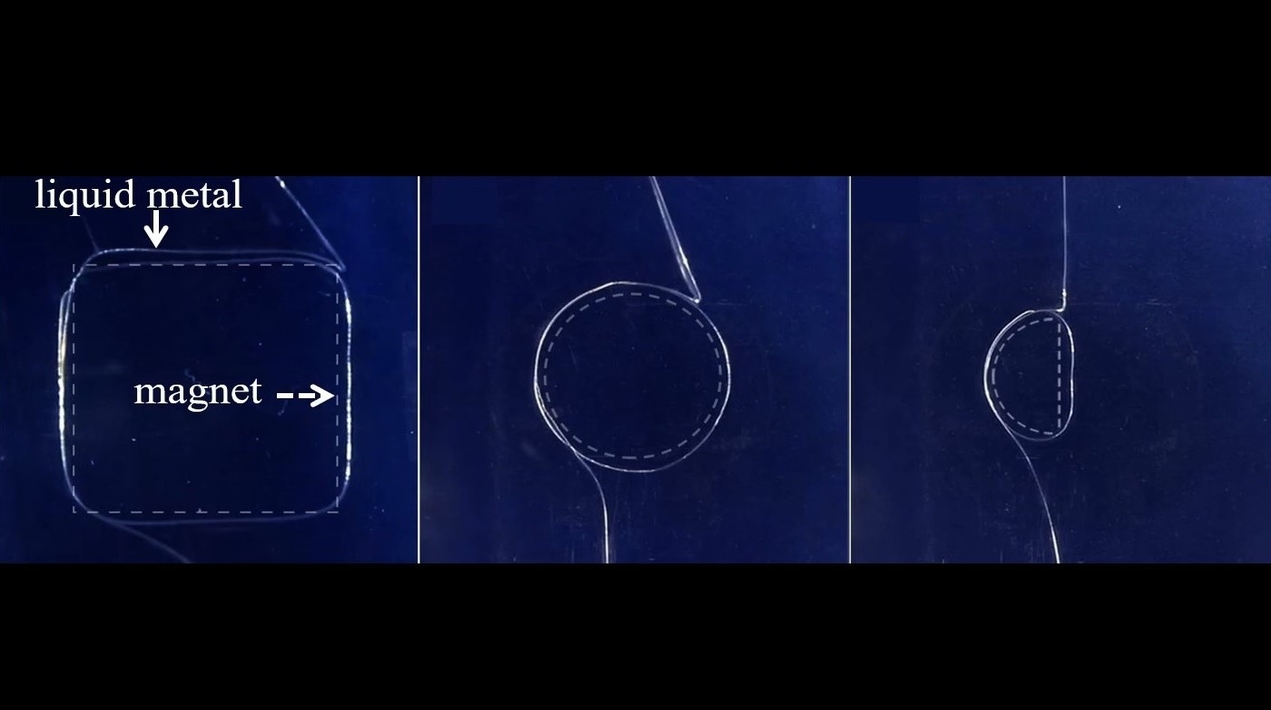
In a landmark discovery, University of Wollongong (UOW) researchers have realised the non-contact manipulation of liquid metal. The metals can be controlled to move in any direction and manipulated into unique, levitated shapes such as loops and squares by using a small voltage and a magnet.
The liquid metal used is galinstan, an alloy of gallium indium and tin, which favours the formation of droplets due to its high surface tension. Under the application of a small triggering voltage, this liquid metal becomes a wire as the voltage causes electrochemical oxidation, which lowers the surface tension of the metal.
The research team was led by Distinguished Professor Xiaolin Wang, a node leader and theme leader at the ARC Centre of Excellence for Future Low-Energy Electronics Technologies (FLEET), and the Director of UOW’s Institute for Superconducting and Electronic Materials within the Australian Institute for Innovative Materials. He noted that by combining electromagnetic induction and fluid dynamics, the team was able to manipulate the liquid metal in a controllable way and move like soft robotics.
The research in liquid metals was inspired by biological systems as well as science fiction, including the shape-shifting, liquid metal “T-1000” robot in the James Cameron-directed film Terminator 2. “This research is more than science fiction, we have conceived and realised this non-contact method for liquids, offering a new way to manipulate and shape fluids,” Prof Wang said.
Because these reactions require an electrical current passing through the wire, it becomes possible to apply a force to the wire via the application of a magnetic field (ie, electromagnetic induction; the same mechanism as drives motion in an electric motor). Thus, the wires can be manipulated to move in a controllable path, and can even be suspended (against gravity) around the circumference of the applied magnetic field, assuming controlled designed shapes.
UOW PhD student Yahua He was the lead author of the study, published in the January issue of Proceedings of the National Academy of Sciences of the United States of America (PNAS), one of the world’s premier journals for multidisciplinary research. He noted that the non-contact manipulation of liquid metal allows researchers to exploit and visualise electromagnetism in new ways.
The ability to control streams of liquid metals in a non-contact manner also enables new strategies for shaping electronically conductive fluids for advanced manufacturing and dynamic electronic structures. Non-contact methods of manufacturing and manipulation can minimise unwanted disturbance of objects being studied or manipulated. Previously developed non-contact technologies include object manipulation by acoustic manipulation or optical tweezers.
However, to date, free-flowing liquid streams have been particularly difficult to manipulate in a non-contact manner. Realising highly controlled changes in directionality or complex shaping of liquids, especially without disrupting the cross-sectional shape of the stream, was the challenge for the team at UOW.
Once the team started working on this topic, they realised that there is much more behind it. The liquid metal wires form by applying a small voltage (approximately 1 volt). However, the team found that a considerable electrical current (up to 70 mA) could be measured in the resulting wires.
“There was a creative leap at this point, as the team realised that electromagnetic induction could be used to control the liquid metal wires in a non-contact manner. This was the key to finally successfully solving the challenge, thereby developing a new strategy for shaping fluids in a non-contact manner,” he added.
This non-contact manipulation is made possible by the material’s unique fluid dynamic and metallic properties. As soft, current-carrying conductors, the wires present minimal resistance to manipulation via Lorentz force under a controlling magnetic field. Thus, the researchers could manipulate the wires in designed ways.
Co-author Professor Michael Dickey from North Carolina State University said this very low resistance to movement allowed unusually fine control of resulting shapes. He said that usually, liquid streams break up into droplets. For example, streams of water coming from a faucet or hose start out as a cylinder, but quickly break up into droplets. However, the liquid metal wire has a string-like property, similar to waving ribbons in the air. That property allowed the researchers to manipulate the liquid metal stream into continuous loops and other shapes.
















